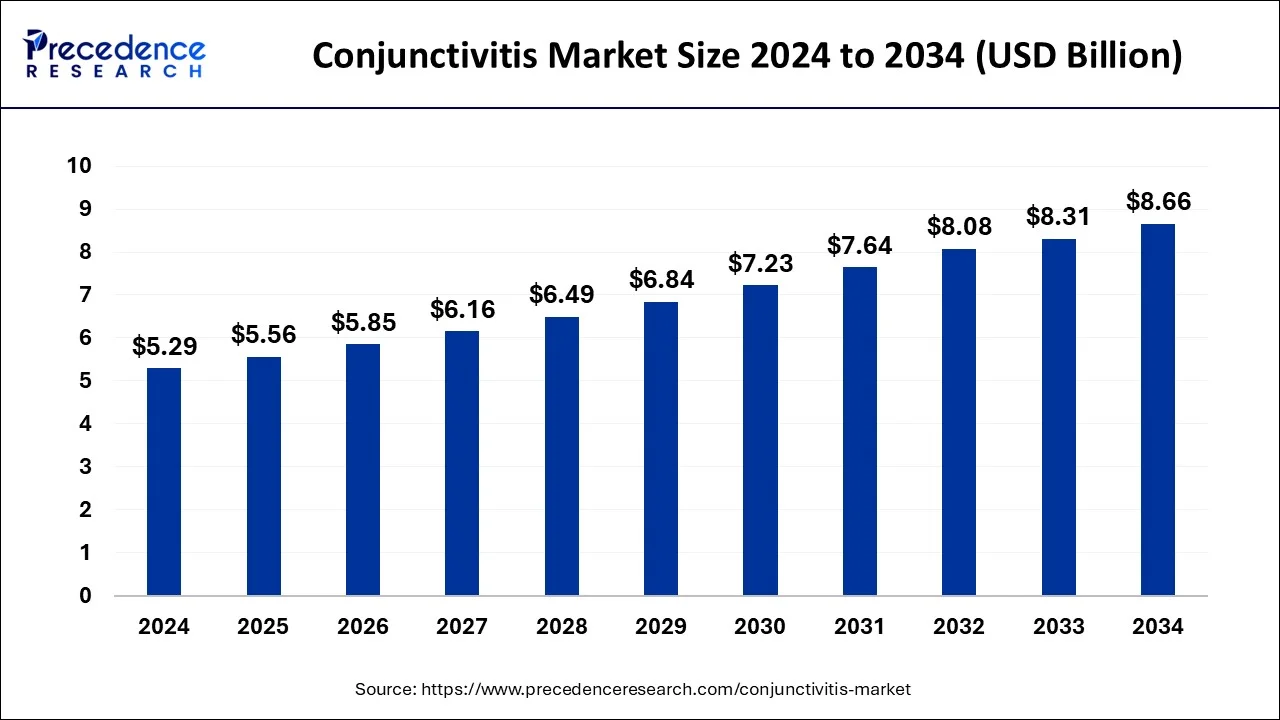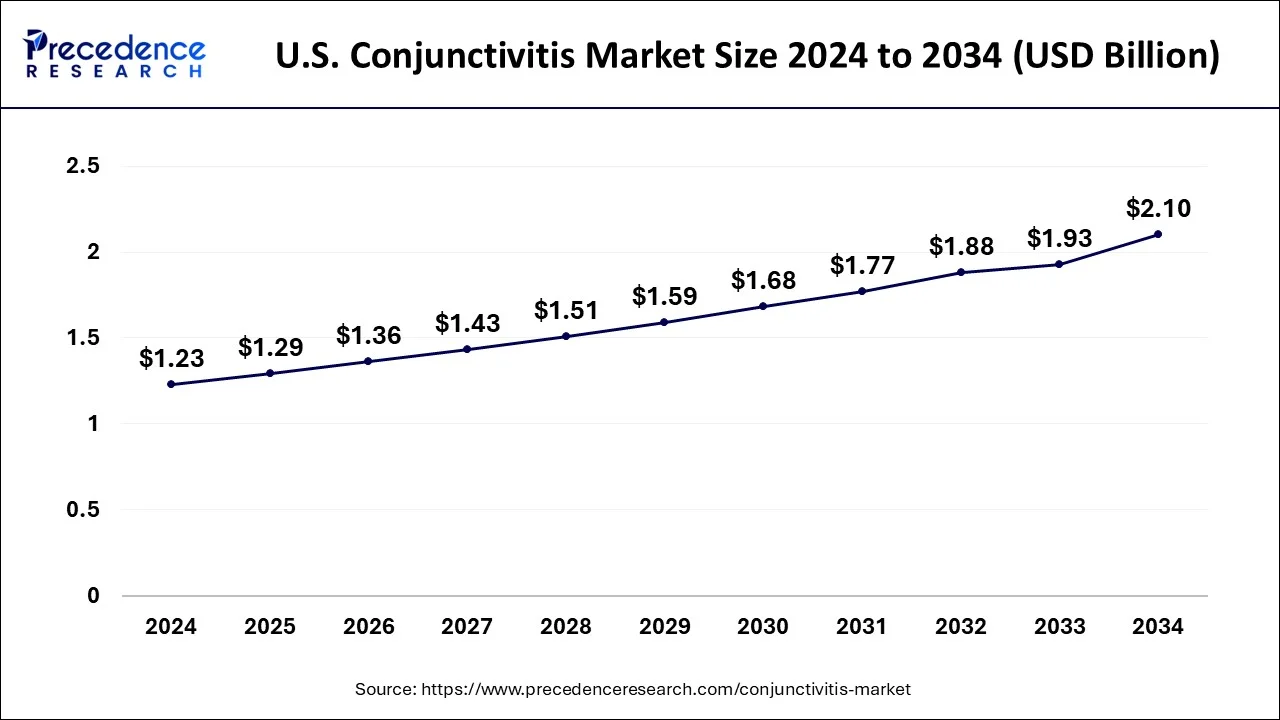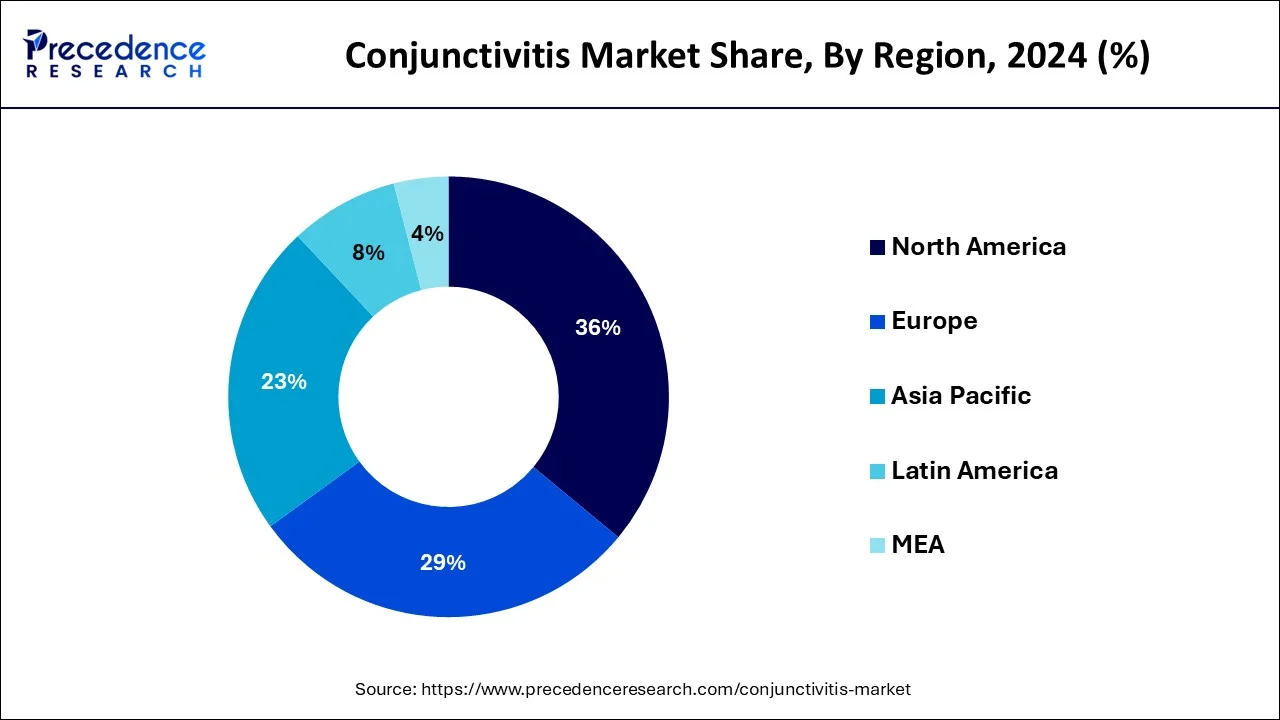The global conjunctivitis market size is calculated at USD 5.56 billion in 2025 and is forecasted to reach around USD 8.66 billion by 2034, accelerating at a CAGR of 5.05% from 2025 to 2034. The North America conjunctivitis market size surpassed USD 1.90 billion in 2024 and is expanding at a CAGR of 5.22% during the forecast period. The market sizing and forecasts are revenue-based (USD Million/Billion), with 2024 as the base year.
The global conjunctivitis market size was estimated at USD 5.29 billion in 2024 and is anticipated to reach around USD 8.66 billion by 2034, expanding at a CAGR of 5.05% from 2025 to 2034. The growing approvals by regulatory agencies for development of effective treatments, rising awareness and the ongoing advancements with increased healthcare expenditure are propelling the conjunctivitis market.

AI can be integrated in conjunctivitis applications for automatic detection and diagnosis of conjunctivitis based on eye images, for analysing the seriousness of eye conditions, predictive maintenance by monitoring disease progression, risk stratification and recommending personalized treatments thereby enabling faster, accurate and objective assessment of different types of conjunctivitis. However, a recently published study in the Allergology International journal in August 2024 stated that the development of potential diagnosing techniques for allergic conjunctival diseases (ACDs) is hindered by the absence of tailored image database and explainable AI models.
The U.S. conjunctivitis market size was evaluated at USD 1.23 billion in 2024 and is predicted to be worth around USD 2.10 billion by 2034, rising at a CAGR of 5.49% from 2025 to 2034.

North America is Estimated to be the Largest Market for Conjunctivitis
The detailed research report covers significant prospects and inclinations of conjunctivitis products throughout different regions including Europe, North America, Asia-Pacific, Africa, Middle East, and Latin America. By region, conjunctivitis market is led by North America due to early application of latest technologies and availability of latest technology infrastructure. Europe reported the second maximum share predominantly due to presence of key companies. Asia-Pacific is also anticipated to witness the rapid growth rate, on account of increasing healthcare expenditure.

Patents on medication such as Lotemax, Patanol, Pataday, and Lastacaft are expected to expire during the forecast period, as well as other medications. Though the frequency of conjunctivitis is higher, the rate of treatment use is not, as the contamination usually rectifies on its own. Treatment is usually sought only when the condition persists or when the infection starts affecting the daily activities of an individual. As the infection is highly contagious, proper maintenance of hygienic conditions is necessary.
Conjunctivitis, also known as pink eye, is an infection in or irritation of the conjunctiva. It disturbs a person's eyes and might be the result of a virus, bacteria, or allergen. Allergens such as pollen, smoke, eye drops, dust mites, perfumes, and cosmetics can result in conjunctivitis. It is typically associated with soreness of the eye accompanied by the release of mucous releases. Although the ailment usually heals without medicine, antibiotics are usually used for treatment to avoid problems due to irritation of the eye.
The timely use of medication to treat the condition helps keep it under control. This can be ensured through educating people about the condition and conducting awareness campaigns. For instance, as part of the efforts of the Lebanese Ministry of Public Health and the Lebanese Ministry of Education and Higher Education, the University of Balamand's Faculty of Health Sciences conducted a conjunctivitis awareness campaign for the students, faculty, and staff of the university. Similarly, Planned Parenthood Arizona published a report about the connection between sexually transmitted infections and conjunctivitis. Educating the public on the treatment options for conjunctivitis increases the chances of individuals identifying the infection and treating it early with medication.
Treatment depends on the stage of conjunctivitis along with the experience of the optometrist. Experienced physicians understand the root cause of the condition easily, which helps reduce the patient's intake of unnecessary medication. Proper treatment reduces the incidence of the condition and avoids the chances of the condition worsening. The treatment options available for conjunctivitis are as follows
| Report Highlights | Details |
| Market Size in 2024 | USD 8.08 billion |
| Market Size in 2025 | USD 8.08 billion |
| Market Size by 2034 | USD 8.08 billion |
| Growth Rate From 2025 to 2034 | CAGR of 5.40% |
| Base Year | 2024 |
| Forecast Period | 2025 to 2034 |
| Segments Covered | Patients, Drug Class, Patients Type |
| Regional Scope | North America, Europe, Asia Pacific, Latin America, Middle East & Africa (MEA) |
Tthe allergic conjunctivitis segment contributed the biggest market share in 2024. High prevalence of allergic conjunctivitis due to high exposure to allergen are the key reason for highest market stake of software segment. The factors such as strong product pipeline and high R&D expenditure are expected to retain the dominance of allergic conjunctivitis in the near future.
The bacterial conjunctivitis segment is anticipated grow at the maximum CAGR through the forecast time-frame mainly due to high prevalence.
Conjunctivitis is highly prevalent among the adult population. Augmented exposure to damaging pollutants and substances is resulting in growth in the quantity of conjunctivitis incidence worldwide. People employed in chemical plants and persons exposed to automobile fumes tend to get allergic conjunctivitis. The rising consciousness of the condition and its handling options are driving market growth.
The prevalent use of anti-histaminic in the effective treatment of conjunctivitis is the key reason for high market share. Steroid Drugs will expand at highest CAGR during the forecast time-frame.
By Type
By Patients Type
By Drug Class
By Geography
For inquiries regarding discounts, bulk purchases, or customization requests, please contact us at sales@precedenceresearch.com
No cookie-cutter, only authentic analysis – take the 1st step to become a Precedence Research client